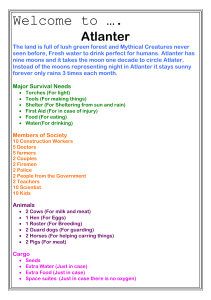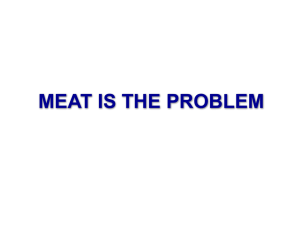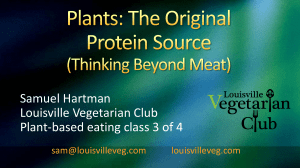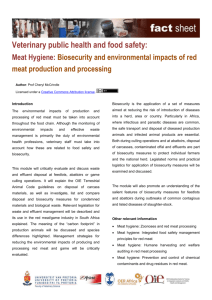Executive summary - Food Standards Australia New Zealand
advertisement
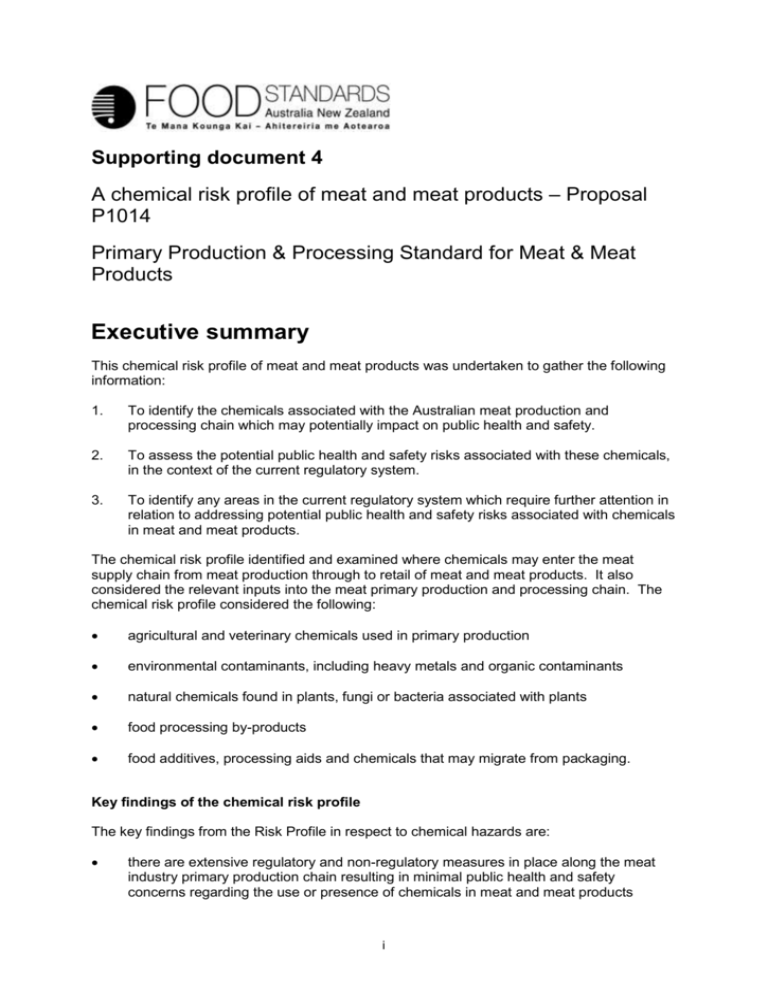
Supporting document 4 A chemical risk profile of meat and meat products – Proposal P1014 Primary Production & Processing Standard for Meat & Meat Products Executive summary This chemical risk profile of meat and meat products was undertaken to gather the following information: 1. To identify the chemicals associated with the Australian meat production and processing chain which may potentially impact on public health and safety. 2. To assess the potential public health and safety risks associated with these chemicals, in the context of the current regulatory system. 3. To identify any areas in the current regulatory system which require further attention in relation to addressing potential public health and safety risks associated with chemicals in meat and meat products. The chemical risk profile identified and examined where chemicals may enter the meat supply chain from meat production through to retail of meat and meat products. It also considered the relevant inputs into the meat primary production and processing chain. The chemical risk profile considered the following: agricultural and veterinary chemicals used in primary production environmental contaminants, including heavy metals and organic contaminants natural chemicals found in plants, fungi or bacteria associated with plants food processing by-products food additives, processing aids and chemicals that may migrate from packaging. Key findings of the chemical risk profile The key findings from the Risk Profile in respect to chemical hazards are: there are extensive regulatory and non-regulatory measures in place along the meat industry primary production chain resulting in minimal public health and safety concerns regarding the use or presence of chemicals in meat and meat products i extensive monitoring of chemical residues in meat over many years has demonstrated a high level of compliance with the regulations continuation of the current management practices, particularly monitoring programs for chemicals along the primary production chain, will ensure that the meat industry continues to maintain a high standard of public health and safety there are a number of areas where further research or monitoring of potential chemical hazards would assist in providing further reassurance that the public health and safety risk is low. ii Table of Contents EXECUTIVE SUMMARY ...............................................................................................................................I KEY FINDINGS OF THE CHEMICAL RISK PROFILE ................................................................................................. I 1. THE CHEMICAL RISK PROFILE ........................................................................................................... 2 1.1 1.2 1.3 1.4 2. CHEMICALS USED IN PRIMARY PRODUCTION ........................................................................................ 2 ENVIRONMENTAL CONTAMINANTS ........................................................................................................ 3 CHEMICALS IN MEAT PRODUCTS FORMED DURING, OR AS A RESULT OF, PROCESSING ...................... 5 CHEMICALS USED IN PROCESSING........................................................................................................ 5 CONCLUSIONS FROM THE CHEMICAL RISK PROFILE .............................................................. 6 1 1. The chemical risk profile 1.1 Chemicals used in primary production Chemicals are used intentionally at the primary production stage for a number of purposes, including pest and weed control and animal health. The agricultural and veterinary chemicals to which meat producing animals are exposed may potentially leave residues in the meat. The most widely used veterinary chemicals are antimicrobials and endo- and ectoparasiticides. Other veterinary chemical uses include those for reproductive therapy, anti-inflammatory drugs or anaesthetics, and hormonal growth promotants1. Insecticides, such as the organophosphates and synthetic pyrethroids are common agricultural chemicals associated with meat production in Australia, and are used as grain protectants and pest control in pastures and feeds. Herbicides are used to reduce weeds and spraying is common in pastures and in pre-pasture establishment. The Australian Pesticides and Veterinary Medicines Authority (APVMA) is responsible for the assessment and registration of pesticides and veterinary medicines and for their regulation up to and including the point of retail sale. Information on all currently registered products is available on the APVMA web-site2. Standard 1.4.2 of the Australia New Zealand Food Standards Code (the Code) lists the maximum permissible limits for agricultural and veterinary chemical residues present in food (maximum residue limits: MRLs). The National Residue Survey (NRS)3, administered by the Department of Agriculture, Fisheries and Forestry (DAFF), monitors residues of agricultural and veterinary chemicals in Australian food commodities including meat. The most recent NRS report (2011-2012)4 includes MRL compliance data on meat from camel, cattle, deer, emu, goat, horse, kangaroo, ostrich, pig, sheep and wild boar. A total of more than 15,000 meat samples were tested (with greater than 280,000 separate analyses) resulting in an overall compliance rate of 99.95%, which is consistent with the high levels of compliance observed in previous years. Compliance rates for the 2011-2012 survey ranged from 97.93% (for horse) to 100% (for camel, deer, goat, kangaroo, emu, ostrich and wild boar). FSANZ has also conducted analytical surveys that have included meat and meat products. For example, the 20th Australian Total Diet Survey (ATDS) investigated the presence of the antibiotics penicillin G, streptomycin and oxytetracycline in a range of meat and meat products5. These substances were not detected in any of the meat/meat product samples. The 23rd ATDS included analysis of the antimicrobial compounds nicarbazin, chloramphenicol and triclabendazole in meat and meat products with no detectable residues reported6. In order to comply with hygienic production and manufacturing practices, cleaning and sanitising agents are utilised throughout the whole production process to ensure that the products remain free from microbial or physical contamination. Sanitisers have the potential to contaminate meat and meat products if quality assurance programs fail and residues are left in equipment. 1 http://www.foodstandards.gov.au/consumer/generalissues/hormonalgrowth/Pages/default.aspx http://www.apvma.gov.au/ 3 http://www.daff.gov.au/agriculture-food/nrs 4 http://www.daff.gov.au/agriculture-food/nrs/animal-product-testing/animal-results-2011-12 2 5 http://www.foodstandards.gov.au/publications/Pages/20thaustraliantotaldietsurveyjanuary2003/20thaustraliantota ldietsurveyfullreport/Default.aspx 6 http://www.foodstandards.gov.au/publications/Pages/23rdaustraliantotald5367.aspx 2 While there are current regulatory and non-regulatory measures in place for chemicals used in primary production, areas of uncertainty have been identified where further compliance data would be valuable. These include residue data relating to the off-label usage of veterinary therapeutics for minor species. 1.2 Environmental contaminants Environmental contaminants such as heavy metals and organic chemicals may enter the meat production chain through stock feed and water or through the direct consumption of soil. Stock feed and water are integral factors in meat production, the quality of which may impinge on the quality of meat produced. Stock feed and water contamination may also result from the presence of endogenous plant toxicants or mycotoxins. Contaminants in food are regulated, in part, by establishing maximum levels (MLs) for various foods in the Code. FSANZ regulates the presence of contaminants in food through Standard 1.4.1 – Contaminants and Natural Toxicants. This Standard sets out the MLs of specified metal and non-metal contaminants and natural toxicants in nominated foods. As a general principle, regardless of whether or not a ML exists, the level of contaminants and natural toxicants in all foods should be kept as low as reasonably achievable (the ALARA principle). However, MLs are only one aspect of a broader risk management framework for food contaminants. Other regulations that encourage practices that in turn reduce contamination of food operate at all levels of government in Australia. These include waste management/disposal programs, water quality programs, industrial zoning regulation and environmental safeguards. The public health risks associated with food contaminants can also be managed through establishing guidelines, codes of practice, or through education of the public on safe food consumption patterns. In many cases, the potential for contamination of food is limited as a result of these other measures, therefore specific food regulation may be unnecessary. When a food standard is considered necessary for a particular contaminant as a risk management measure, this is achieved by establishing an ML in particular food commodities. MLs are the legal limits enforced through the State and Territory Food Acts and are, in general, used only when other mechanisms of control are considered insufficient or inadequate to safeguard the health of consumers. The Department of Sustainability, Environment, Water, Population and Communities (DSEWPaC) plays an important role in the management of chemical environmental contaminants. DSEWPaC undertakes environmental assessments of industrial and agricultural chemicals for the National Industrial Chemicals Notification and Assessment Scheme (NICNAS) and the APVMA. The National Pollutant Inventory7, which is coordinated by DSEWPaC, provides the community, industry and government with information about substance emissions in Australia. It currently has emissions data for 93 substances/ substance classes that have been identified as important due to their potential effects on human health and the environment. The National Residue Survey, while focussing primarily on agricultural and veterinary chemicals (see above), also monitors some environmental contaminants in Australian food commodities including meat. Inclusion of particular contaminants in these surveys depends on the results of previous surveys, the likelihood of significant contamination, and the potential public health risk associated with the contaminant. 7 http://www.npi.gov.au/ 3 Heavy metals such as cadmium, lead and mercury and other elements such as arsenic and selenium can potentially contaminate meat products through their presence in soil, uptake by crops used in stockfeed or metal contamination during processing. Metals may enter soil through agricultural practices, for example, as components of fertilisers and/or industrial contamination. For example, phosphorus fertilisers may contain cadmium at relatively high levels and this may have contributed to the accumulation of excessive levels of cadmium in offal (notable liver and kidney) recently reported in some countries. However, consumption of offal is relatively low in Australia and the resulting contribution of offal to overall cadmium exposure would be expected to be minimal. The objectives of the National Cadmium Minimisation Strategy included the minimisation of cadmium levels in fertilisers8. The Fertiliser Industry Federation of Australia has agreed to progressively reduce the levels of cadmium in phosphate fertilisers by making greater use of rock phosphate with low cadmium content. In addition to the consumption of crops grown in soils with high metal contents, animals may be exposed to metal contaminants by directly consuming soil. Soil consumption may vary depending on the grazing pattern, climate and pasture characteristics, and may be greater for animals grazing dryer pastures close to the ground. Meat is a relatively small contributor to the overall dietary intake such elements and, at the current levels found in meat, there are no public health and safety concerns. Overall, the data suggests that stock feed and soil do not significantly contribute to heavy metal and other element contamination of meat. Persistent organic pollutants (POPs) such as dioxins can occur naturally in the environment although the major source is from industrial practices. The term ‘dioxins’ is used to describe a group of environmentally persistent halogenated aromatic hydrocarbon chemicals that include polychlorinated dibenzodioxins (PCDDs), polychlorinated dibenzofurans (PCDFs), polybrominated dibenzodioxins (PBDDs) and polybrominated dibenzofurans (PBDFs). PCDDs, PCDFs, PBDDs and PBDFs are not manufactured intentionally but are by-products of combustion. They are formed naturally by volcanoes and forest fires, as well as by industrial processes such as waste incineration and the synthesis of certain chemicals. A major source of potential exposure to POPs is through the diet. Because of the lipid solubility of some POPs, meat products can be a significant source of dietary exposure. The Code does not contain an ML for dioxins; however, results from a survey published in 2004 indicated that levels of dioxins in Australia’s meat are low and compare favourably with overseas products in terms of dioxin contamination9. In this survey, none of the meat samples contained dioxin levels exceeding the European Union (EU) standard. It is concluded that there are no public health and safety concerns with the current levels of dioxins in meat and meat products. Unlike dioxins, polychlorinated biphenyls (PCBs) do not occur naturally in the environment; they are derived from man-made products which were manufactured for approximately 50 years for use as components of insulating fluids in transformers and other electrical equipment. A range of surveys has indicated that PCBs are either not detected or detected at very low levels in the Australian food supply. The low level of dietary exposure is well below the reference health standard. It is concluded that there are no public health and safety concerns associated with residues of PCBs in meat and meat products11. Persistent organochlorines such as DDT, dieldrin, heptachlor and hexachlorobenzene have not been available for use in Australia since the 1970s. However, they are still present in soils where they were used for spot and broad acre pest control. 8 9 http://www.cadmium-management.org.au http://www.foodstandards.gov.au/publications/Pages/dioxinsinfood/Default.aspx 4 These compounds have been de-registered in Australia for many years as agricultural pesticides, but due to their persistent nature in the environment, particularly in soil, low concentrations have been sporadically identified in meat. However, it is considered that the likelihood of regularly consuming meat or meat products containing residue levels that are high enough to present a potential risk to health is extremely low. It can therefore be concluded that dietary exposure to environmental contaminants from meat and meat products does not raise public health and safety concerns. Naturally occurring toxins of plant, fungal and bacterial origin are potential contaminants in stock feed. These include aflatoxins, ochratoxin, trichothecene toxins, zearalenone, fumonisins, corynetoxins, pyrrolizidine and quinolizidine alkaloids, ptaquiloside, indospicine, phomopsins and zearalenone. Critical controls to ensure that stockfeed is free from toxins include on-farm controls for pasture management (Good Agricultural Practice). FSANZ is not aware of any reports of adverse effects in humans due to the ingestion of such toxins via meat consumption. Further research and continued monitoring would assist in providing additional reassurance that the public health and safety risk from naturally occurring toxins is low. Finally, some biological and chemical substances that are regulated by the APVMA could be potentially used for other purposes and ultimately be present as a contaminant in feed, for example, which is not regulated by the APVMA. A number of standards relating to animal feed have been adopted into the international food code (Codex Alimentarius) and two draft guidelines are currently under consideration10. 1.3 Chemicals in meat products formed during, or as a result of, processing Chemicals can be formed within meat and meat products due to microbiological activity or processing. Biogenic amines, such as tyramine, tryptamine and histamine, can be produced in fermented meat products in particular. There are reports from case studies indicating that biogenic amines may present a health concern for some individuals. Polycyclic aromatic hydrocarbons (PAHs) are by-products of cooking processes and have been found in meat products. In 2010, FSANZ published the results of an analytical survey of PAHs in Australian foods including meat and meat products11. The resulting data were used to perform a dietary exposure assessment for Australian population groups. The risk characterisation concluded that dietary exposure to PAHs is unlikely to be of public health and safety concern. 1.4 Chemicals used in processing Food additives and processing aids are used in the manufacture of a wide range of meat products. Food additives may be added to achieve a technological function in the final food, such as preservation or colouring, whereas processing aids fulfil a technological function during processing, but do not perform a technological function in the final food. The use of food additives and processing aids is regulated in the Code by maximum permitted use levels or according to Good Manufacturing Practice (GMP). At the end of the production chain, packaging may also lead to the unintentional migration of chemicals from the packaging material into meat products. 10 http://www.daff.gov.au/agriculture-food/codex/committees/animal-feeding 11 http://www.foodstandards.gov.au/science/monitoring/surveillance/Pages/surveyofpolycyclicar4818.aspx 5 There is a paucity of data on the levels of migration of chemicals from packaging materials into foods in general, however where information on migration is available the levels are very low. Migration of chemicals from packaging into meat and meat products is not considered to present a risk to human health and safety. 2. Conclusions from the Chemical Risk Profile There are extensive regulatory and non-regulatory measures in place to ensure that chemicals used or present in meat and meat products present a very low public health and safety risk. The regulations and control measures currently in place along the meat primary production chain have resulted in minimal public health and safety concerns regarding the use or presence of chemicals in meat and meat products. The extensive monitoring of chemical residues in meat over many years has demonstrated a high level of compliance with the regulations. The chemical risk profile has also identified a number of areas where further research or monitoring would assist in providing further reassurance that the public health and safety risk is low. Continuation of the current management practices, particularly monitoring programs for chemicals along the primary production chain, will ensure that the meat industry continues to maintain a high standard of public health and safety. 6



